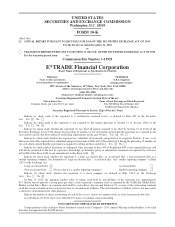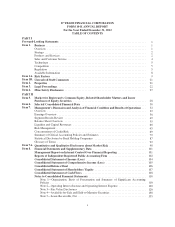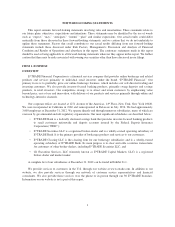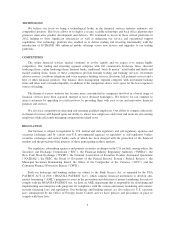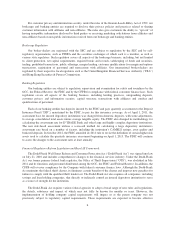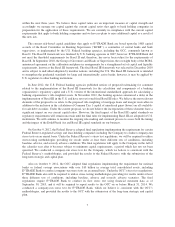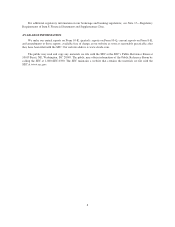eTrade 2012 Annual Report Download - page 10
Download and view the complete annual report
Please find page 10 of the 2012 eTrade annual report below. You can navigate through the pages in the report by either clicking on the pages listed below, or by using the keyword search tool below to find specific information within the annual report.within the next three years. We believe these capital ratios are an important measure of capital strength and
accordingly we manage our capital against the current capital ratios that apply to bank holding companies in
preparation for the application of these requirements. We are currently in compliance with the current capital
requirements that apply to bank holding companies and we have no plans to raise additional capital as a result of
this new law.
The current risk-based capital guidelines that apply to E*TRADE Bank are based upon the 1988 capital
accords of the Basel Committee on Banking Supervision (“BCBS”), a committee of central banks and bank
supervisors, as implemented by the U.S. Federal banking agencies, including the OCC, commonly known as
Basel I. The Basel II framework was finalized by U.S. banking agencies in 2007; however, E*TRADE Bank did
not meet the threshold requirements for Basel II and, therefore, has never been subject to the requirements of
Basel II. In September 2010, the Group of Governors and Heads of Supervision, the oversight body of the BCBS,
announced agreement on the calibration and phase-in arrangements for a strengthened set of capital and liquidity
requirements, known as the Basel III framework. The final Basel III framework was released in December 2010
and is subject to individual adoption by member nations, including the U.S. The Basel III framework is intended
to strengthen the prudential standards for large and internationally active banks; however, it may be applied by
U.S. regulators to other banking institutions.
In June 2012, the U.S. Federal banking agencies published notices of proposed rulemaking for comment
related to the implementation of the Basel III framework for the calculation and components of a banking
organization’s regulatory capital and a U.S. version of the international standardized approach for calculating a
banking organization’s risk-weighted assets. In November 2012, the banking agencies announced a delay in the
implementation of Basel III in the U.S. and have not yet issued final Basel III rules. We believe the most relevant
elements of the proposal to us relate to the proposed risk-weighting of mortgage loans and margin receivables in
addition to the inclusion in the calculation of Common Tier 1 capital of unrealized gains (losses) on all available-
for-sale debt securities. Under the current proposal, we do not believe the incorporation of these elements have a
significant impact on our current capital ratios. However, the final impact of the Basel III capital standards on
regulatory requirements will remain uncertain until the final rules for implementing Basel III are adopted for U.S.
institutions. We will continue to monitor the ongoing rule-making and comment process to assess both the timing
and the impact of the Dodd-Frank Act and Basel III capital standards on our business.
On October 9, 2012, the Federal Reserve adopted final regulations implementing the requirement for certain
Federal Reserve-regulated savings and loan holding companies including the Company to conduct company-run
stress tests on an annual basis. Under the Federal Reserve’s stress test regulations, we will be required to utilize
stress-testing methodologies providing for results under at least three different sets of conditions, including
baseline, adverse, and severely adverse conditions. The final regulations will apply to the Company in the fall of
the calendar year after it becomes subject to minimum capital requirements, a period which has not yet been
specified. We conducted a company-run stress test for the Company, which we believe is consistent with the
Federal Reserve’s methodologies, and provided the results to the Federal Reserve with the submission of the
long-term strategic and capital plan.
Also on October 9, 2012, the OCC adopted final regulations implementing the requirement for national
banks or federal savings associations with over $10 billion in average total consolidated assets, including
E*TRADE Bank to conduct company-run stress tests on an annual basis. Under the OCC’s stress test regulations,
E*TRADE Bank also will be required to utilize stress-testing methodologies providing for results under at least
three different sets of conditions, including baseline, adverse and severely adverse scenarios. The final
regulations require E*TRADE Bank to conduct its first stress test using financial statement data as of
September 30, 2013, and it will be required to report results to the OCC on or before March 31, 2014. We
conducted a company-run stress test for E*TRADE Bank, which we believe is consistent with the OCC’s
methodologies, and provided the results to the OCC with the submission of the long-term strategic and capital
plan.
7

